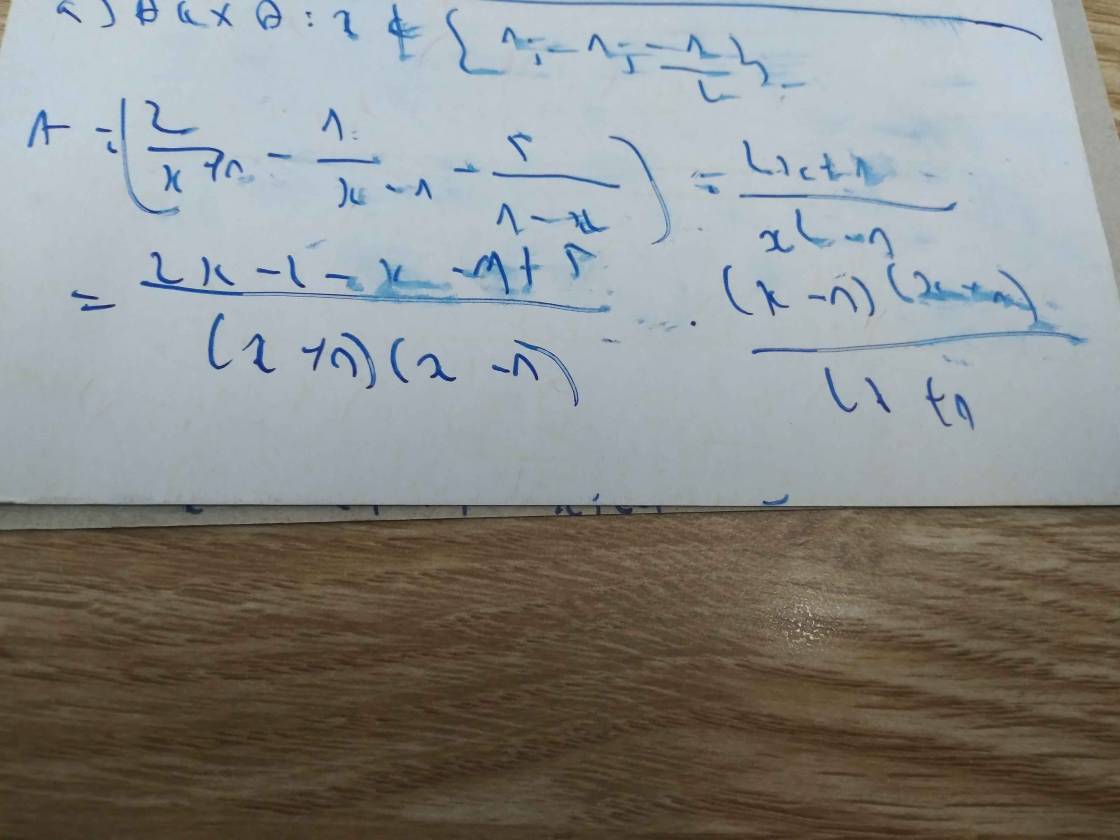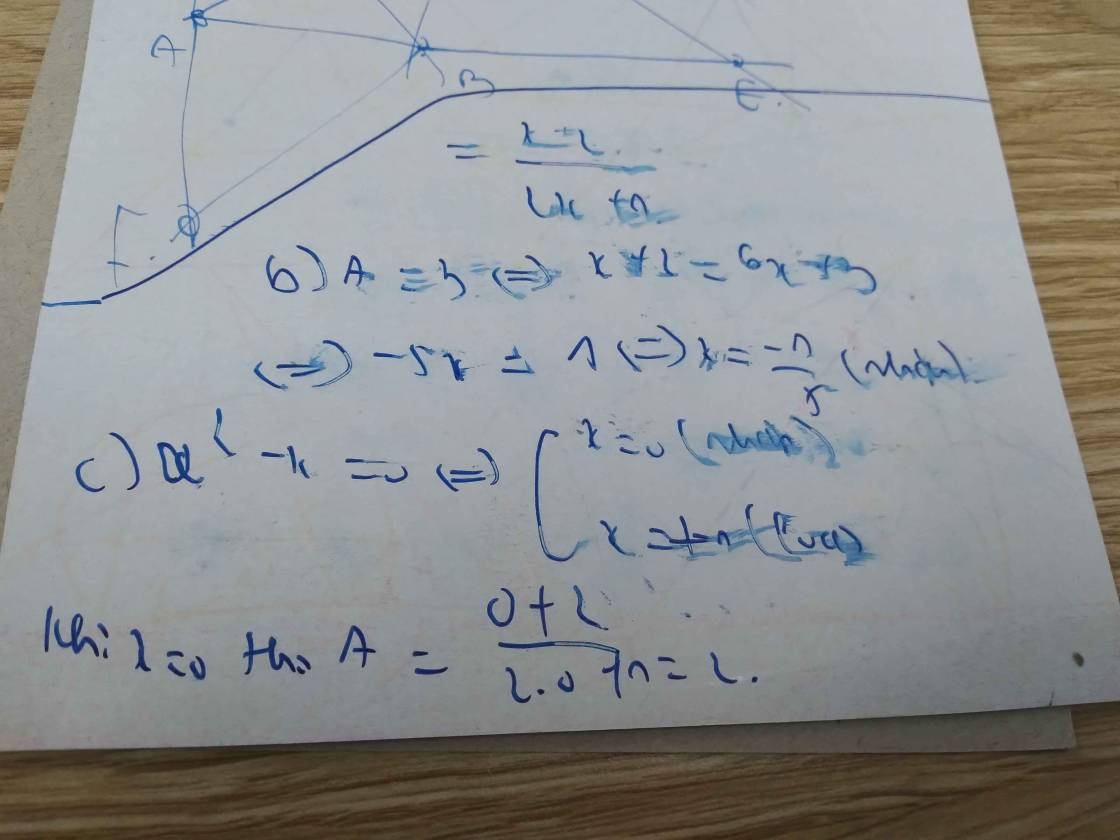Tìm giá trị của x để: a+x<a
Hãy nhập câu hỏi của bạn vào đây, nếu là tài khoản VIP, bạn sẽ được ưu tiên trả lời.


a) ĐKXĐ: \(x\notin\left\{5;-5\right\}\)
b) Ta có: \(A=\dfrac{2x}{x^2-25}+\dfrac{5}{5-x}-\dfrac{1}{x+5}\)
\(=\dfrac{2x}{\left(x-5\right)\left(x+5\right)}-\dfrac{5}{x-5}-\dfrac{1}{x+5}\)
\(=\dfrac{2x}{\left(x-5\right)\left(x+5\right)}-\dfrac{5\left(x+5\right)}{\left(x-5\right)\left(x+5\right)}-\dfrac{x-5}{\left(x+5\right)\left(x-5\right)}\)
\(=\dfrac{2x-5x-25-x+5}{\left(x-5\right)\left(x+5\right)}\)
\(=\dfrac{-4x-20}{\left(x-5\right)\left(x+5\right)}\)
\(=\dfrac{-4\left(x+5\right)}{\left(x-5\right)\left(x+5\right)}\)
\(=\dfrac{-4}{x-5}\)
Để A nguyên thì \(-4⋮x-5\)
\(\Leftrightarrow x-5\inƯ\left(-4\right)\)
\(\Leftrightarrow x-5\in\left\{1;-1;2;-2;4;-4\right\}\)
hay \(x\in\left\{6;4;7;3;9;1\right\}\)(nhận)
Vậy: Để A nguyên thì \(x\in\left\{6;4;7;3;9;1\right\}\)

a) ĐKXĐ: x≠ \(\dfrac{1}{2}\); x≠ \(\dfrac{-1}{2}\); x≠0
A= \(\left(\dfrac{1}{2x-1}+\dfrac{3}{1-4x^2}-\dfrac{2}{2x+1}\right):\dfrac{x^2}{2x^2+x}\)
= \(\left(\dfrac{2x+1-3-2\left(2x-1\right)}{4x^2-1}\right):\dfrac{x^2}{2x^2+x}\)
= \(\left(\dfrac{2x+1-3-4x+2}{4x^2-1}\right):\dfrac{x^2}{2x^2+x}\)
= \(\dfrac{-4x}{\left(2x+1\right)\left(2x-1\right)}.\dfrac{x\left(2x+1\right)}{x^2}\)
= \(\dfrac{-4x^2}{x^2\left(2x-1\right)}\)
= \(\dfrac{-4}{2x-1}\)
b) Tại x= -2 ta có A= \(\dfrac{-4}{2.\left(-2\right)-1}\)= \(\dfrac{4}{5}\)
c) A= 4 ta có \(\dfrac{-4}{2x-1}\)=4
⇔ -4 = 4(2x-1)
⇔ -4 = 8x-4
⇔ x = 0
d) A=1 ta có \(\dfrac{-4}{2x-1}\)=1
⇔ -4 = 2x-1
⇔ x= \(\dfrac{-3}{2}\)

a: \(A=\sqrt{x}+\dfrac{\sqrt{x}\left(1+2\sqrt{x}\right)}{\sqrt{x}\left(\sqrt{x}+1\right)}=\sqrt{x}+\dfrac{2\sqrt{x}+1}{\sqrt{x}+1}\)
Khi x=4 thì \(A=2+\dfrac{2\cdot2+1}{2+1}=2+\dfrac{5}{3}=\dfrac{11}{3}\)
b: Khi x=(2-căn 3)^2 thì \(A=2-\sqrt{3}+\dfrac{2\left(2-\sqrt{3}\right)+1}{2-\sqrt{3}+1}\)
\(=2-\sqrt{3}+\dfrac{4-2\sqrt{3}+1}{3-\sqrt{3}}\)
\(=2-\sqrt{3}+\dfrac{5-2\sqrt{3}}{3-\sqrt{3}}\)
\(=\dfrac{\left(2-\sqrt{3}\right)\left(3-\sqrt{3}\right)+5-2\sqrt{3}}{3-\sqrt{3}}\)
\(=\dfrac{6-2\sqrt{3}-3\sqrt{3}+3+5-2\sqrt{3}}{3-\sqrt{3}}\)
\(=\dfrac{14-7\sqrt{3}}{3-\sqrt{3}}\)
d: A=2
=>\(\dfrac{x+\sqrt{x}+2\sqrt{x}+1}{\sqrt{x}+1}=2\)
=>\(x+3\sqrt{x}+1=2\left(\sqrt{x}+1\right)=2\sqrt{x}+2\)
=>\(x+\sqrt{x}-1=0\)
=>\(\left[{}\begin{matrix}\sqrt{x}=\dfrac{-1+\sqrt{5}}{2}\left(nhận\right)\\\sqrt{x}=\dfrac{-1-\sqrt{5}}{2}\left(loại\right)\end{matrix}\right.\Leftrightarrow x=\dfrac{6-2\sqrt{5}}{4}=\dfrac{3-\sqrt{5}}{2}\)

a) Ta có: \(M=\dfrac{8x+1}{4x-5}=\dfrac{8x-10+11}{4x-5}=\dfrac{2\left(x-5\right)+11}{4x-5}=2+\dfrac{11}{4x-5}\)
Để M nhận giá trị nguyên thì \(2+\dfrac{11}{4x-5}\) nhận giá trị nguyên
\(\Rightarrow\dfrac{11}{4x-5}\) nhận giá trị nguyên
\(\Rightarrow11⋮4x-5\)
Vì \(x\in Z\) nên \(4x-5\in Z\)
\(\Rightarrow4x-5\inƯ\left(11\right)=\left\{\pm1;\pm11\right\}\)
\(\Rightarrow x\in\left\{1;\pm1,5;4\right\}\)
Vậy \(x\in\left\{1;4\right\}\) thỏa mãn \(x\in Z\).
b) Ta có: \(A=\dfrac{5}{4-x}\). ĐK: \(x\ne4\)
Nếu 4 - x < 0 thì x > 4 \(\Rightarrow A>0\)
4 - x > 0 thì x < 4 \(\Rightarrow A< 0\)
Để A đạt GTLN thì 4 - x là số nguyên dương nhỏ nhất
\(\Rightarrow4-x=1\Rightarrow x=3\)
\(\Rightarrow A=\dfrac{5}{4-3}=5\)
Vậy MaxA = 5 tại x = 3
c) \(B=\dfrac{8-x}{x-3}\). ĐK: \(x\ne3\).
Ta có: \(B=\dfrac{8-x}{x-3}=\dfrac{-\left(x-8\right)}{x-3}=\dfrac{-\left(x-3\right)+5}{x-3}=\dfrac{5}{x-3}-1\)
Để B đạt giá trị nhỏ nhất thì \(\dfrac{5}{x-3}-1\) nhỏ nhất
\(\Rightarrow\dfrac{5}{x-3}\) nhỏ nhất
Nếu x - 3 > 0 thì x > 3 \(\Rightarrow\dfrac{5}{x-3}>0\)
x - 3 < 0 thì x < 3 \(\Rightarrow\dfrac{5}{x-3}< 0\)
Để \(\dfrac{5}{x-3}\) nhỏ nhất thì x - 3 là số nguyên âm lớn nhất
\(\Rightarrow x-3=-1\Rightarrow x=2\)
\(\Rightarrow B=\dfrac{8-2}{2-3}=-6\)
Vậy MaxB = -6 tại x = 2.
Mình làm sai câu a...
Ta có: \(M=\dfrac{8x+1}{4x-1}=\dfrac{8x-2+3}{4x-1}=\dfrac{2\left(4x-1\right)+3}{4x-1}=2+\dfrac{3}{4x-1}\)
Để M nhận giá trị nguyên thì \(2+\dfrac{3}{4x-1}\) nhận giá trị nguyên
\(\Rightarrow\dfrac{3}{4x-1}\) nhận giá trị nguyên
Vì \(4x-1\in Z\) nên \(4x-1\inƯ\left(3\right)=\left\{\pm1;\pm3\right\}\)
\(\Rightarrow x\in\left\{\pm0,5;0;1\right\}\)
Vậy \(x\in\left\{0;1\right\}\) thỏa mãn \(x\in Z\).






Để a+x < a
=> x < 0
\(a+x< a\)
\(\Leftrightarrow x< 0\)